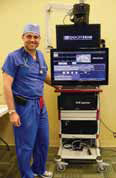Client: Doctor Brandon Winchester
Challenge: When he’s not performing ultrasound-guided regional anesthesia, Dr. Winchester likes to teach others how to do it. For the past several years, he has traveled from his home base at the Andrews Institute in Gulf Breeze, FL, to observe and teach other physicians and nurses as they learn new techniques in this specialty. But, he says, he ran into a problem with this training method: “I couldn’t get out and reach enough doctors who needed this education.”
Solution: He wanted a way to reach more doctors. He felt high-quality on-demand videos could help in this regard. His vision included using multiple cameras to stream live procedures to the web. Since no product existed that would allow him to do all of this, he knew he would have to build his own solution. So, that’s what he did. He literally went into his garage and built a portable video production unit. He dubbed it “DOC-IN-THE-BOX” (DITB).
Integrator: ClarkPowell, www.clark-powell.com
Details: Winchester uses DITB to broadcast live procedures over the internet and to produce “studio set” videos. After Winchester selected the components, he teamed up with the engineers at ClarkPowell to perfect the design.
At its core, the unit consists of a pair of customized pole carts. The ClarkPowell team installed a 19-inch equipment rack in the base of the primary cart for the switcher/scaler, and a Windows-based CPU. The primary cart also houses an ultrasound machine with built-in display, two HD displays, and a Vaddio HD-PTZ camera. The secondary cart holds an additional HD-PTZ camera and an iPad, which controls the system. All of these components interact wirelessly.
“I remember being quite impressed that the Vaddio camera cost about 25 percent less than the next-closest comparable model among other manufacturers. Yet the gears in that camera are so smooth, I can get a real cinematic effect,” Winchester says.
The switcher/scaler manages the video inputs from Vaddio cameras, the ultrasound machine and the PC, and then sends the signals to the displays for in-room viewing and to the PC for video capture and streaming. ClarkPowell designed dual, simultaneous system control that allows users to control the solution either using an iPad running a custom Crestron iPad app or through an XPanel interface on the PC. The control devices feature 10 presets. These presets make it easy for Winchester to switch between video sources and change camera angles or zoom settings during a procedure.
Contact: Vaddio, www.vaddio.com










